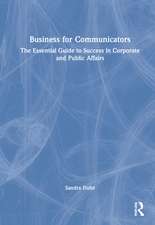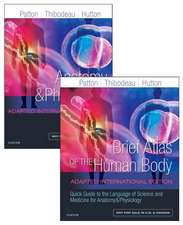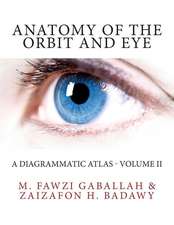Oxidative Stress, Cell Activation and Viral Infection: Molecular and Cell Biology Updates
Autor C. Pasquieren Limba Engleză Paperback – 24 apr 2012
Din seria Molecular and Cell Biology Updates
- 5%
 Preț: 375.34 lei
Preț: 375.34 lei - 15%
 Preț: 585.04 lei
Preț: 585.04 lei - 5%
 Preț: 653.87 lei
Preț: 653.87 lei - 15%
 Preț: 641.71 lei
Preț: 641.71 lei - 5%
 Preț: 369.84 lei
Preț: 369.84 lei - 15%
 Preț: 649.06 lei
Preț: 649.06 lei -
 Preț: 393.35 lei
Preț: 393.35 lei -
 Preț: 394.29 lei
Preț: 394.29 lei -
 Preț: 396.02 lei
Preț: 396.02 lei - 5%
 Preț: 368.37 lei
Preț: 368.37 lei -
 Preț: 414.14 lei
Preț: 414.14 lei -
 Preț: 392.21 lei
Preț: 392.21 lei -
 Preț: 403.15 lei
Preț: 403.15 lei - 5%
 Preț: 1418.12 lei
Preț: 1418.12 lei -
 Preț: 407.01 lei
Preț: 407.01 lei -
 Preț: 400.65 lei
Preț: 400.65 lei - 15%
 Preț: 596.69 lei
Preț: 596.69 lei
Preț: 376.22 lei
Preț vechi: 396.02 lei
-5% Nou
Puncte Express: 564
Preț estimativ în valută:
72.01€ • 74.89$ • 60.34£
72.01€ • 74.89$ • 60.34£
Carte tipărită la comandă
Livrare economică 14-28 martie
Preluare comenzi: 021 569.72.76
Specificații
ISBN-13: 9783034874267
ISBN-10: 303487426X
Pagini: 380
Ilustrații: XII, 362 p.
Dimensiuni: 170 x 244 x 20 mm
Greutate: 0.6 kg
Ediția:1994
Editura: Birkhäuser Basel
Colecția Birkhäuser
Seria Molecular and Cell Biology Updates
Locul publicării:Basel, Switzerland
ISBN-10: 303487426X
Pagini: 380
Ilustrații: XII, 362 p.
Dimensiuni: 170 x 244 x 20 mm
Greutate: 0.6 kg
Ediția:1994
Editura: Birkhäuser Basel
Colecția Birkhäuser
Seria Molecular and Cell Biology Updates
Locul publicării:Basel, Switzerland
Public țintă
ResearchCuprins
DNA glycosylases involved in the repair of oxidized bases in Escherichia coli.- Potential role of protein oxidation and proteasome in antigen processing.- Involvement of hydrogen peroxide in the actions of TGF ?1.- Oxidative stress and growth factor-mediated signal transduction.- Cellularly generated active oxygen species as signals in the activation of tumour cell growth.- Effect of oxygen radicals on the IL-1 production by monocytes and IL-2 receptor expression in lymphocytes during primary and secondary immunodeficiency.- The effect of reactive oxygen species (ROS) on human T and B lymphoid cells.- Leukocyte adhesion and endothelial cytokine production in hypoxia/reoxygenation.- Effects of antioxidants on IL-6 secretion induced by IL-1 in human cultured lung fibroblasts. Involvement of NF kB.- Hydrogen peroxide-induced synthesis of the 32kDa stress protein (HO-1) in endothelial cells is serum dependent.- The antioxidant effects of glutathione and ascorbic acid.- Structural consequences of NF-kB inhibition by natural antioxidants: ?-lipoic acid and vitamin E.- d-?-tocopherol and cell proliferation.- Effects of intracellular redox status on cellular regulation and viral infection.- Mechanisms of regulation of cell growth by cytokines of the immune system.- Oxidization of human low density lipoproteins measured by Laser Doppler electrophoresis.- Selective modulation of brain antioxidant defense capacity by genetic or metabolic manipulations.- Protective effect of Poly(A)-poly(U) against immune oxidative injury. Role of thiols released by activated macrophages.- Reactive oxygen, antioxidants, and autotoxicity in viral diseases.- Redox control of gene expression by eukaryotic transcription factors NF-kB, AP-1 and SRF/TCF.- Redox mechanisms in Tcell activation.-Implication of oxydative phenomena in T cell activation.- Intracellular damages induced by singlet oxygen are signals for HIV-1 reactivation.- Abnormal redox regulation in HIV infection and other immunodeficiency diseases.- Influence of redox status of lymphocytes and monocytes on HIV expression and immune functions. Evaluation in vitro of antioxidant molecules as potential anti-HIV therapy.- Place for an antioxidant therapy in human immunodeficiency virus (HIV) infection.- Prevention of early cell death in peripheral blood lymphocytes of HIV infected individuals by an antioxidant: N-Acetyl-cysteine.- Alcanes measurements in human immunodeficiency virus infection.- Plasma antioxidant status (selenium, retinol and ?-tocopherol) in HIV infection.- Author index.- Keyword index.







